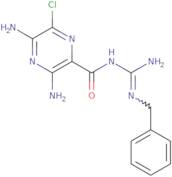Informations sur le produit
- 2-Pyrazinecarboxamide, 3,5-diamino-6-chloro-N-[imino[(phenylmethyl)amino]methyl]-
- 3,5-Diamino-6-chloro-N-(imino((phenylmethyl)amino)methyl)pyrazinecarboxamide
- 3,5-Diamino-6-chloro-N-[imino[(phenylmethyl)amino]methyl]-2-pyrazinecarboxamide
- 3,5-diamino-N-(N'-benzylcarbamimidoyl)-6-chloropyrazine-2-carboxamide
- 3,5-diamino-N-(benzylcarbamimidoyl)-6-chloropyrazine-2-carboxamide hydrochloride
- Benzylamiloride
- N-(N-Benzylamidino)-3,5-diamino-6-chloropyrazine carboxamide
- Pyrazinecarboxamide, 3,5-diamino-6-chloro-N-(imino((phenylmethyl)amino)methyl)-
- Pyrazinecarboxamide, 3,5-diamino-N-(benzylamidino)-6-chloro-
Benzamil is a drug that is a weak inhibitor of the potassium-chloride channel. It has been shown to have low potency in rat hippocampal neurons and does not produce neuronal death at physiological concentrations. The binding site for benzamil has been localized to the α subunit of the channel. This drug may also interact with other drugs by inhibiting their transport across cell membranes, thereby altering their pharmacokinetics. Benzamil has been used as a model system to study the effects of amiloride on neuronal excitability and neurotransmitter release in rat hippocampal neurons. In addition, it can be used to study drug interactions by examining how benzamil and amiloride affect fetal bovine brain tissue exposed to potassium chloride.





